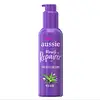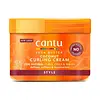Aussie Miracle Repairer Bonding Serum Versus Cantu Shea Butter For Natural Hair Coconut Curling Cream
What's inside
What's inside
 Key Ingredients
Key Ingredients

No key ingredients
 Benefits
Benefits

 Concerns
Concerns

 Ingredients Side-by-side
Ingredients Side-by-side

Water
Skin ConditioningDimethicone
EmollientAloe Barbadensis Leaf Juice
Skin ConditioningCetyl Alcohol
EmollientStearamidopropyl Dimethylamine
EmulsifyingStearyl Alcohol
EmollientSorbitan Caprylate
EmulsifyingBenzyl Alcohol
PerfumingHydroxyethylcellulose
Emulsion StabilisingQuaternium-18
Parfum
MaskingPEG-2m
Emulsion StabilisingCetearyl Alcohol
EmollientOleyl Alcohol
EmollientGlyceryl Stearate
EmollientCitric Acid
BufferingPolysorbate 60
EmulsifyingLysine Hcl
Skin ConditioningEDTA
Water, Dimethicone, Aloe Barbadensis Leaf Juice, Cetyl Alcohol, Stearamidopropyl Dimethylamine, Stearyl Alcohol, Sorbitan Caprylate, Benzyl Alcohol, Hydroxyethylcellulose, Quaternium-18, Parfum, PEG-2m, Cetearyl Alcohol, Oleyl Alcohol, Glyceryl Stearate, Citric Acid, Polysorbate 60, Lysine Hcl, EDTA
Water
Skin ConditioningCetearyl Alcohol
EmollientCanola Oil
EmollientGlycerin
HumectantCeteareth-20
CleansingParfum
MaskingCeteth-20
CleansingButyrospermum Parkii Butter
Skin ConditioningGlycol Stearate
EmollientPetrolatum
EmollientPEG-75
HumectantPolyquaternium-10
Phenoxyethanol
PreservativeEthylhexylglycerin
Skin ConditioningCocos Nucifera Fruit Extract
EmollientPersea Gratissima Oil
Skin ConditioningPrunus Amygdalus Dulcis Oil
Skin ConditioningSimmondsia Chinensis Seed Oil
EmollientOlea Europaea Fruit Oil
MaskingMangifera Indica Seed Butter
Skin ConditioningArgania Spinosa Kernel Oil
EmollientMelia Azadirachta Seed Oil
EmollientDaucus Carota Sativa Seed Oil
EmollientMacadamia Ternifolia Seed Oil
EmollientMangifera Indica Seed Oil
EmollientGlycine Soja Oil
EmollientVitis Vinifera Seed Oil
EmollientHydrolyzed Silk
HumectantLonicera Caprifolium Flower Extract
PerfumingMacrocystis Pyrifera Extract
Skin ConditioningSalvia Officinalis Leaf Extract
CleansingVitis Vinifera Seed Extract
AntimicrobialUrtica Dioica Extract
AstringentSilk Amino Acids
HumectantAloe Barbadensis Leaf Juice
Skin ConditioningBenzyl Benzoate
AntimicrobialCoumarin
PerfumingHexyl Cinnamal
PerfumingWater, Cetearyl Alcohol, Canola Oil, Glycerin, Ceteareth-20, Parfum, Ceteth-20, Butyrospermum Parkii Butter, Glycol Stearate, Petrolatum, PEG-75, Polyquaternium-10, Phenoxyethanol, Ethylhexylglycerin, Cocos Nucifera Fruit Extract, Persea Gratissima Oil, Prunus Amygdalus Dulcis Oil, Simmondsia Chinensis Seed Oil, Olea Europaea Fruit Oil, Mangifera Indica Seed Butter, Argania Spinosa Kernel Oil, Melia Azadirachta Seed Oil, Daucus Carota Sativa Seed Oil, Macadamia Ternifolia Seed Oil, Mangifera Indica Seed Oil, Glycine Soja Oil, Vitis Vinifera Seed Oil, Hydrolyzed Silk, Lonicera Caprifolium Flower Extract, Macrocystis Pyrifera Extract, Salvia Officinalis Leaf Extract, Vitis Vinifera Seed Extract, Urtica Dioica Extract, Silk Amino Acids, Aloe Barbadensis Leaf Juice, Benzyl Benzoate, Coumarin, Hexyl Cinnamal
 Reviews
Reviews

Ingredients Explained
These ingredients are found in both products.
Ingredients higher up in an ingredient list are typically present in a larger amount.
Aloe Barbadensis Leaf Juice comes from leaves of the aloe plant. Aloe Barbadensis Leaf Juice is best known for helping to soothe sunburns. It is also anti-inflammatory, moisturizing, antiseptic, and can help heal wounds.
Aloe is packed with good stuff including Vitamins A, C, and E. These vitamins are antioxidants, which help fight free-radicals and the damage they may cause. Free-radicals are molecules that may damage your skin cells, such as pollution.
Aloe Barbadensis Leaf Juice also contains sugars. These sugars come in the form of monosaccharides and polysaccharides, folic acid, and choline. These sugars are able to help bind moisture to skin.
It also contains minerals such as calcium, 12 anthraquinones, fatty acids, amino acids, and Vitamin B12.
Learn more about Aloe Barbadensis Leaf JuiceCetearyl alcohol is a mixture of two fatty alcohols: cetyl alcohol and stearyl alcohol. It is mainly used as an emulsifier. Emulsifiers help prevent the separation of oils and products. Due to its composition, it can also be used to thicken a product or help create foam.
Cetearyl alcohol is an emollient. Emollients help soothe and hydrate the skin by trapping moisture.
Studies show Cetearyl alcohol is non-toxic and non-irritating. The FDA allows products labeled "alcohol-free" to have fatty alcohols.
This ingredient is usually derived from plant oils such as palm, vegetable, or coconut oils. There is debate on whether this ingredient will cause acne.
Due to the fatty acid base, this ingredient may not be Malassezia folliculitis safe.
Learn more about Cetearyl AlcoholParfum is a catch-all term for an ingredient or more that is used to give a scent to products.
Also called "fragrance", this ingredient can be a blend of hundreds of chemicals or plant oils. This means every product with "fragrance" or "parfum" in the ingredients list is a different mixture.
For instance, Habanolide is a proprietary trade name for a specific aroma chemical. When used as a fragrance ingredient in cosmetics, most aroma chemicals fall under the broad labeling category of “FRAGRANCE” or “PARFUM” according to EU and US regulations.
The term 'parfum' or 'fragrance' is not regulated in many countries. In many cases, it is up to the brand to define this term.
For instance, many brands choose to label themselves as "fragrance-free" because they are not using synthetic fragrances. However, their products may still contain ingredients such as essential oils that are considered a fragrance by INCI standards.
One example is Calendula flower extract. Calendula is an essential oil that still imparts a scent or 'fragrance'.
Depending on the blend, the ingredients in the mixture can cause allergies and sensitivities on the skin. Some ingredients that are known EU allergens include linalool and citronellol.
Parfum can also be used to mask or cover an unpleasant scent.
The bottom line is: not all fragrances/parfum/ingredients are created equally. If you are worried about fragrances, we recommend taking a closer look at an ingredient. And of course, we always recommend speaking with a professional.
Learn more about ParfumWater. It's the most common cosmetic ingredient of all. You'll usually see it at the top of ingredient lists, meaning that it makes up the largest part of the product.
So why is it so popular? Water most often acts as a solvent - this means that it helps dissolve other ingredients into the formulation.
You'll also recognize water as that liquid we all need to stay alive. If you see this, drink a glass of water. Stay hydrated!
Learn more about Water